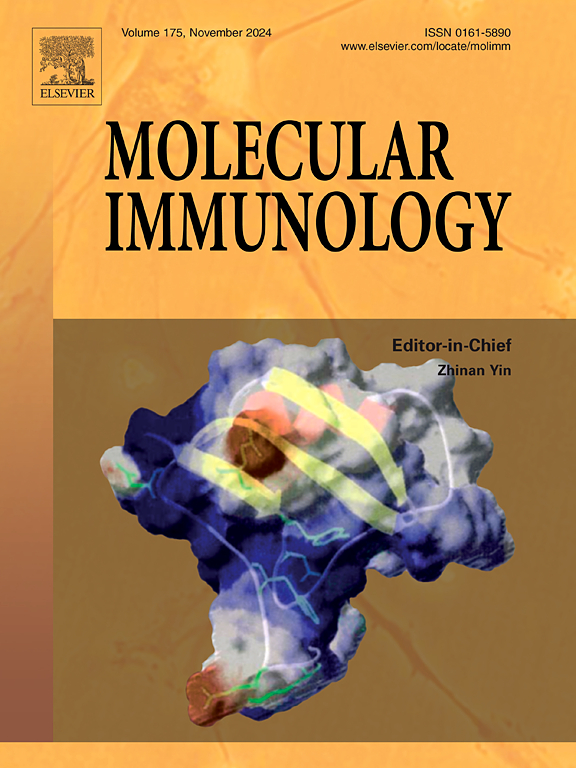耐受性树突状细胞对胶原性关节炎大鼠TLR4/MyD88/NF-κB信号通路的影响
IF 3
3区 医学
Q2 BIOCHEMISTRY & MOLECULAR BIOLOGY
引用次数: 0
摘要
目的类风湿关节炎(RA)是一种常见的炎症性自身免疫性疾病。先前的研究强调耐受性树突状细胞(toldc)可以通过诱导RA动物模型的特异性免疫耐受来减轻炎症病变,但其机制仍有待进一步研究。本研究的重点是揭示toldc对介导炎症的TLR4/MyD88/NF-κB信号通路的影响。方法采用IL-4、GM-CSF和NF-κB寡核苷酸诱饵诱导骨髓源性toldc。流式细胞术检测toldc表面dc特异性分子OX-62和共刺激分子CD80、CD86。采用H&;E染色、Safranine O-fast绿色染色和抗酒石酸酸性磷酸酶(TRAP)染色评估关节损伤,并采用H&;E染色评估脾脏组织组织学变化。采用免疫组化(IHC)方法分别检测踝关节滑膜、软骨和骨组织TLR4/MyD88/NF-κB信号通路关键蛋白。免疫荧光法(IF)观察NF-κB p65核易位及磷酸化NF-κB p65 (p-NF-κB p65)的亚细胞定位。结果对CIA大鼠进行干预后,其关节炎症和破坏明显减轻。此外,tolDCs抑制CIA大鼠踝关节滑膜、软骨和骨组织细胞TLR4/MyD88/NF-κB信号通路的过度激活。结论stoldc可能通过抑制TLR4/MyD88/NF-κB信号通路的过度激活来减轻CIA大鼠的炎症反应。本文章由计算机程序翻译,如有差异,请以英文原文为准。
The effects of tolerogenic dendritic cells on the TLR4/MyD88/NF-κB signaling pathway in rats with collagen-induced arthritis
Objective
Rheumatoid arthritis (RA) is a common inflammatory autoimmune disease. Previous studies have emphasized tolerogenic dendritic cells(tolDCs) could attenuate inflammatory lesions by inducing specific immune tolerance in RA animal models, but the mechanism still needs further investigation. This study focused on revealing the effects of tolDCs on the TLR4/MyD88/NF-κB signaling pathway that mediates inflammation.
Methods
Bone marrow-derived tolDCs were induced by IL-4, GM-CSF and NF-κB Oligonucleotide Decoys. The DC-specific molecule OX-62 and co-stimulatory molecules CD80 and CD86 on the surface of tolDCs were detected by flow cytometry. Joint damage was assessed by H&E, Safranine O-fast green staining and tartrate-resistant acid phosphase (TRAP) staining, and the histological change of spleen tissue was also evaluated by H&E staining. Immunohistochemistry (IHC) was performed to detect key proteins of TLR4/MyD88/NF-κB signaling pathway of synovium, cartilage, and bone tissues of ankle joints respectively. Immunofluorescence (IF) was performed to observe NF-κB p65 nuclear translocation and subcellular localization of phosphorylated NF-κB p65 (p-NF-κB p65).
Results
The intervention of tolDCs showed a significant reduction in joint inflammation and destruction in CIA rats. Moreover, tolDCs suppressed the hyperactivation of the TLR4/MyD88/NF-κB signaling pathway of the cells in synovium, cartilage and bone tissues of ankle joints in CIA rats.
Conclusions
TolDCs may exert therapeutic effects on CIA rats by alleviating the inflammation through inhibiting the hyperactivation of the TLR4/MyD88/NF-κB signaling pathway.
求助全文
通过发布文献求助,成功后即可免费获取论文全文。
去求助
来源期刊

Molecular immunology
医学-免疫学
CiteScore
6.90
自引率
2.80%
发文量
324
审稿时长
50 days
期刊介绍:
Molecular Immunology publishes original articles, reviews and commentaries on all areas of immunology, with a particular focus on description of cellular, biochemical or genetic mechanisms underlying immunological phenomena. Studies on all model organisms, from invertebrates to humans, are suitable. Examples include, but are not restricted to:
Infection, autoimmunity, transplantation, immunodeficiencies, inflammation and tumor immunology
Mechanisms of induction, regulation and termination of innate and adaptive immunity
Intercellular communication, cooperation and regulation
Intracellular mechanisms of immunity (endocytosis, protein trafficking, pathogen recognition, antigen presentation, etc)
Mechanisms of action of the cells and molecules of the immune system
Structural analysis
Development of the immune system
Comparative immunology and evolution of the immune system
"Omics" studies and bioinformatics
Vaccines, biotechnology and therapeutic manipulation of the immune system (therapeutic antibodies, cytokines, cellular therapies, etc)
Technical developments.
 求助内容:
求助内容: 应助结果提醒方式:
应助结果提醒方式:


